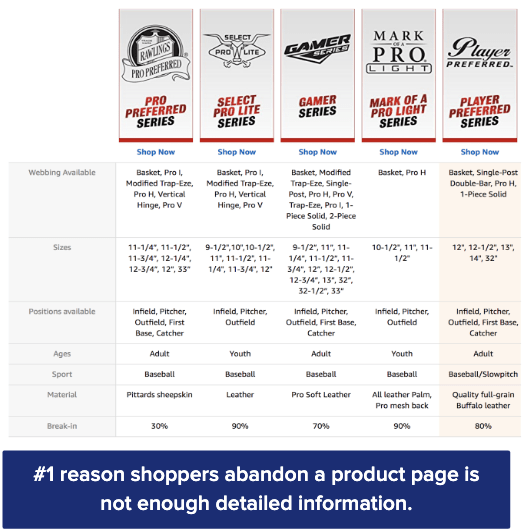Aligning your eCommerce Search Engine Optimization (SEO) strategy with the latest SEO trends will enable your business to rank higher in search queries, attract more traffic to your website, and keep a leg up on your competition.
In this post, you’ll learn seven eCommerce trends that will help you optimize your content strategy. These trends are a good starting point for your marketing team to follow.
We will cover the following trends:
Let’s get started.
1. Search Intent Focus
Almost all search engines now understand the context of the user search query.
This is why Google can tell the difference between the three main types of searches:
- Informational searches (“red sneakers for running”)
- Band-specific navigational (“red Nike running shoes”)
- Or transactional searches (“best red running shoes under $100”)
Marketers must understand search intent and adjust their marketing strategies to align with the various user intents. That can be achieved in two primary ways: including long-tail keywords and creating a content stack that aligns with the user’s search intent.
By matching SEO optimization and content to the intent, you are better able to boost results within Google and other search platforms.
Let’s take a look at how this comes into play for the two leading search intent types: Informational and transactional, and the types of content you should be creating for each.
Informational Search Intent
The informational search represents the top of the funnel, where the buyer wants to learn more about the product or service.
Let’s say you’re creating content for an informational search. Informational searches are an indication that the potential buyer is looking for general and educational information on the topic. Content in the form of in-depth guides, blogs, checklists, or a list of tips and other educational posts provides the best fit for informational queries.
Transactional Search Intent
Transactional searches are at the other end of the spectrum. The transactional search finds the shopper ready to buy the product and represents the bottom of the funnel.
The prospect has informed themselves and is now ready to purchase. Hence, the content should reassure the buyer that they are making the right choice. For these searches, you could have a product comparison article, for example.
Let’s not forget about voice search. Optimizing for voice search is necessary if you want to keep up with SEO trends. To do that,
- You’ll first need to familiarize yourself with Natural Language Processing and how it influences voice search.
- Then, optimize your website and content for voice search.
You may also need to answer your buyer’s frequently asked questions, for example. This, in turn, increases the chances of your content being used to answer queries done through voice search.
Pro Tip: To really capitalize on SEO, you should boost your strategies and change keywords with the right Google Ads for eCommerce. Why? When planned well, organic and paid search strategies should boost each other, ensuring you get maximum exposure for the least amount of spend — AKA, great ROAS.
Even better, if you then implement advanced PPC automation and management, you can improve ROAS even further.
[embedded content]
2. AI Content
GPT-3 (third-generation Generative Pre-trained Transformer) was unveiled last year through OpenAI. As a result, automation tools have become quite popular among online stores and other businesses.
Let’s say you usually use recurring emails to follow up with potential buyers, invoice suppliers with the same bill, etc. AI tools could help you automate these emails for enhanced efficiency.
Content tools like CopyAi, Headline, and Jarvis are quickly becoming popular as well. These tools won’t replace your content teams but will make the content generation process more efficient.
How? They are designed to help your team generate more SEO-optimized content faster. They include email writing software and tools for:
- Writing titles
- Meta tags
- Product descriptions
AI-generated content is, at best, a great starting point for your content team in areas like research, SEO-rich headlines, and plagiarism-free content that needs the human touch in editing.
Here are some practical ways to utilize AI content tools:
- Topic generation. Speed up the creativity and brainstorming process with AI-generated topics for your eCommerce blog.
- Meta tag and meta description generation. The tool can help you generate meta tags, page titles, and descriptions when you’re writing meta descriptions at scale.
- Outlines/first drafts. AI tools still create content with errors and unnatural phrasing. However, they provide a good launching pad to make your first draft, speeding up the content creation process.
As an SEO trend, AI content generation tools will improve as AI evolves.
3. Increased Focus on Mobile Optimization
The following SEO trend relates to where the user conducts their online search. More than half of online search queries are generated from mobile devices, including tablets. In addition, Google’s mobile-first indexing prioritizes a website’s mobile version for indexing and ranking.
Therefore, optimizing your online store for mobile devices is one easy way to boost conversions. So, the question is, how do you optimize your online store for mobile devices?
There are various things you’ll need to do. The key among them being that you ensure your site:
- Is responsive
- Loads fast
Remember that mobile devices have a much smaller screen. That means your product images, text, buttons, etc., must be optimized for smaller screens. Your customer must be able to click your CTAs with ease. Additionally, they’ll need to read your product descriptions without straining. The text should also be readable without forcing the shopper to scroll horizontally.
Page speed time is also critical. In fact, a report shared by Google shows that conversion rates may drop by up to 20% for every second a mobile page takes to load. Multiple other studies have shown similar results.
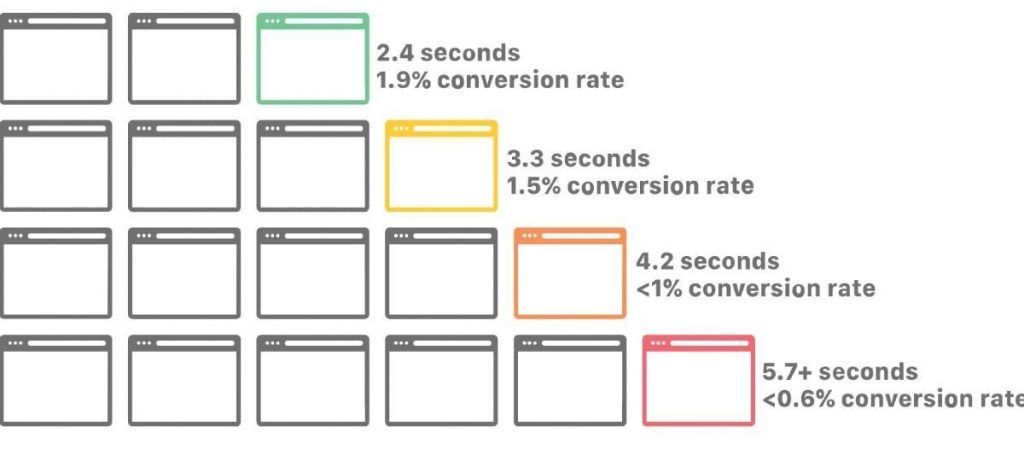
[Source: Cloudflare]
You also have to consider that shoppers on mobile devices are susceptible to tons of distractions. For example, a social media notification could pop up at any moment. So every second your site delays loading is another second the shopper could get distracted and abandon the purchase.
Here are some tips to help you optimize your store’s loading speed:
- Compress images
- Fast and responsive themes
- Minimize redirects and external HTTP requests
- Minimize the number of apps installed
- Get a reliable eCommerce hosting provider

Personalization is also really critical for shoppers on mobile devices. Try to tailor each customer’s experience based on their needs and behaviors. For example, you could pick and recommend related products based on a shopper’s purchase history. If you don’t have any data from the shopper, try using an “other customers also bought” section.
Beyond these strategies, it’s worth testing your site for mobile-friendliness. Luckily, Google provides a free mobile-friendly test tool. Paste your store’s URL and the tool will run a quick test before producing results showing whether your online store is mobile optimized.
4. Long-Form Content is Still #1
Long-form content still rules in 2022, and the average blog post on your website should be a 1,600-word or seven-minute read. Look at the infographic below from Canirank that measures word length and SERP ranking on Google.
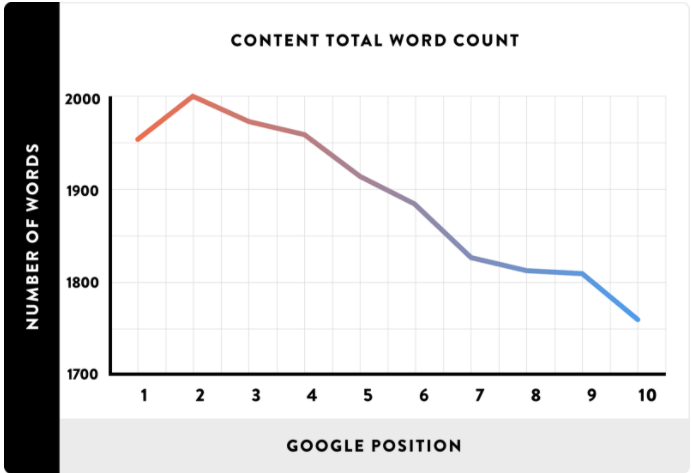
[Source: Canirank]
However, this does not mean that every page of your website should have 1,800–2,000 words. Short-form content has its place on your website.
For example, it wouldn’t make sense to write a 2,000-word product description for every item in your store. Instead, you’ll get better results with brief product descriptions that clearly articulate the product’s benefits to your buyers. You can read more about this in our How to Create Perfect Product Pages for Conversions post.
On the other hand, if you’re creating a case study or other eCommerce blog content, you may need long-form content to tell the story behind your product and how it can generate the intended results.
When you look at your store site, it helps to think of long-form content as the meals and the short-form content as the snacks you have between meals.
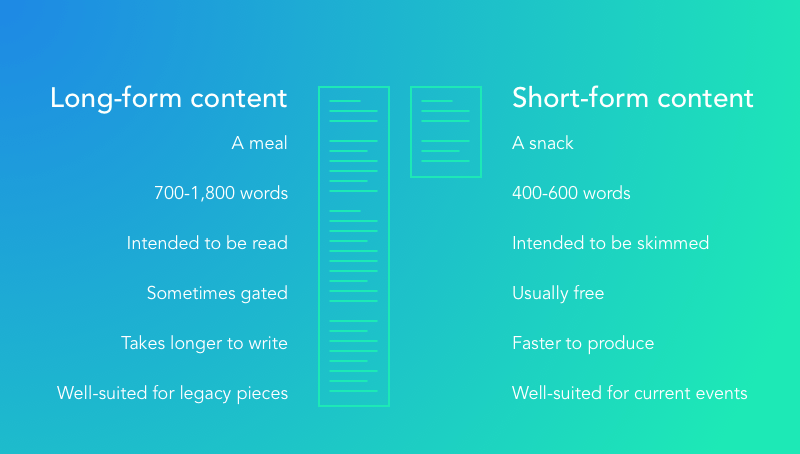
[Source: MarketMuse]
The content on your home page is one example of short-form content. You want to keep the page clean and simple while providing all relevant information for the shopper to browse further.
Your contact and product pages are other examples where you need short-form content.
So how do you optimize your site for this SEO trend?
How to Optimize Your Store for SEO Long-Format Trends
You will want to aim at a minimum of 400 words on product pages, and 1,500 to 2,000-word blogs can help you score better on search rankings. When creating long-form blog content, you will want to ensure that you:
- Divide your content into headings and subheadings
- Maintain a conversational tone and avoid buzzwords
- Hook the reader with a catchy introduction
- Add relevant visuals to break up the text
To review your store, scan your website and remove old content that is too short, incomplete, or irrelevant to the user’s intent. Replace this content with fresh, optimized, long-form content.
Why? Because lengthier content pieces get more attention and shares, improving the website’s ranking and domain authority. But remember, quality matters!
Google has repeatedly stressed that content quality is critical for ranking on SERPs. Hence, it’s essential to qualify the definition of good content. Quality is down to the EAT principle, which stands for expertise, authoritativeness, and trustworthiness. The more closely your content aligns with these markers, the more likely your content will rank.
Pro Tips: Here are two additional tips on how you can get the most out of long-form content:
- By creating content hubs and topic clusters on your store blog, you can segment your content according to the interests of different personality types across your target audience.
- You can also use guest posting on third-party sites to generate backlinks that point to your long-form content. This will improve the authority and ranking of those pages.
5. Rise in Need for Video SEO
YouTube is the second-largest search engine after Google. What does that tell us? Modern consumers like video content. However, it’s short videos that are dominating.
While there is a niche audience for long videos (over 5 minutes), marketers are learning that more people prefer short-form videos that get straight to the point.
These videos take lesser bandwidth and are what consumers want to view across different demographics. The instant popularity and growth of platforms like Snapchat and TikTok further testify to this trend.
Bottom line: Your video content requires SEO treatment if you want to keep up with the competition.
This involves focusing on your videos’ meta title, meta description, and meta tags. Additionally, you will want to ensure that you add the metadata information in the video thumbnail and description tag.
Why? Search engines pick up on the metadata to identify and rank your videos.
If you create many videos for your website, consider creating a video sitemap that makes it easier for search engine bots to crawl your website. A video sitemap is a text file containing all relevant data about your videos. With this site map, the Google bots look at each video and classify it based on the title, content, and run time.
6. Google Discover Optimization
A new and fun addition to the list of SEO trends for 2022 is the inclusion of Google Discover.
What is Google Discover?
Well, it’s a feed that collects all relevant information based on a user’s search trends and places the results at the top of the search page. Think of it as a feed on topics that interest the person based on what they searched for in the past.

[Source: Search Engine Land]
Google Discover returns results across different media types, including the latest stories, articles, and videos.
To optimize your content for Google Discover, look at creating both new and evergreen content, use high-quality images, create trustworthy content, and offer multilingual content, as shown above.
You want to stay focused on creating great content that aligns with the interest and needs of your target audience. That increases the chance of Google adding your page to Google Discover, thereby bringing in more relevant organic traffic.
7. Google’s “People Also Ask”
A recent study of 2.5 million search queries revealed that Google’s “People also ask” feature displays on nearly half of all organic searches. It’s Google’s way of enhancing the user experience on the search engine.
Its prominent placement towards the top of the SERP (as with the case of featured snippets) means getting your content ranking in this coveted SERP feature is critical to your digital marketing efforts.
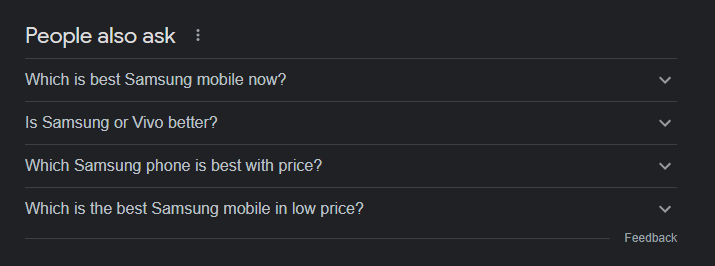
Your site and blog content need to answer shoppers’ common questions about the search topic for it to appear in that section. Here’s how:
- Start by looking at the SERPs and keywords to identify long-tail question keywords relevant to your audience.
- Next, ensure that your content provides comprehensive answers, including questions in your H2s and H3s.
- You may also want to add an FAQ section at the end of your blog content.
This strategy is a great way to gain higher visibility at the top of SERPs in 2022. Higher visibility translates to increased traffic and more potential buyers.
Wrapping up
Tracking SEO trends and tweaking your SEO techniques is vital to securing a high ranking for your eCommerce store and its content. These seven SEO trends will enable you to effectively tweak your SEO strategy in 2022.
While these SEO trends are a good starting point in your digital marketing strategy, you also need to focus on the evergreen markers like creating engaging, informative, and value-rich content for your audience.
These evergreen trends combined with the new trends are the most efficient way to increase organic traffic and rank higher in the SERPs.


Sam Molony
Sam is part of the marketing team at Mailshake. Sam’s goal is to inspire people to not just “hang in there” but to thrive. When Sam’s not publishing or promoting new content, you can find him playing sports and cooking up a storm in the kitchen.
Comments
comments
Powered by Facebook Comments




